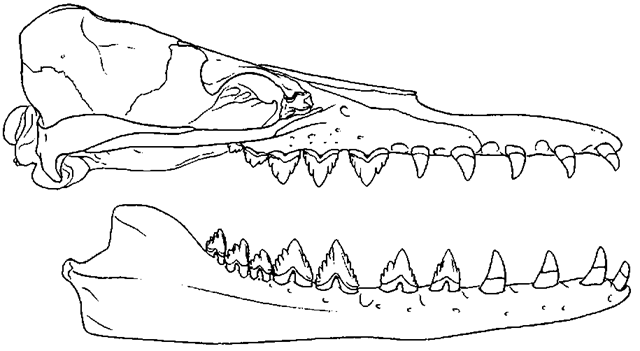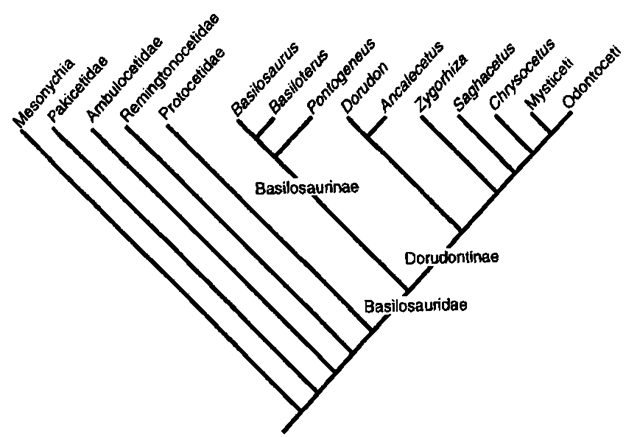Basilosaurids are a paraphyletic group of archaeocete , cetaceans known from the late middle to early late Eocene of all continents except Antarctica and South America. The family includes 11 species in 8 genera in 2 subfamilies, although some authors elevate the subfamilies to familial rank. They range in size from around 4 m (Saghacetus osiris) to around 16 m (Basllosaurxis cetoides). Basilosaurids are probably the earliest fully aquatic cetaceans (Ulien, 1998) and are draught to have given rise to modem cetaceans (Barnes et al, 1985; Uhen, 1998).
I. Basilosaurid Characteristics
Like all archaeocetes, basilosaurids lack telescoping of the skull like that seen in modern mysticetes or like that seen in modern odontocetes (see Fig. 1; Miller, 1923). In addition, basilosaurids are diphyodont, lack polydonty, and retain a het-erodont dentition in which incisors, canines, premolars, and molars are easy to distinguish based on their morphologies (Kellogg, 1936; Uhen, 1998).
Basilosaurids also share a number of characteristics that distinguish them from other archaeocetes. All basilosaurids lack up per third molars and the upper molars lack protocones, trigon basins, and lingual third roots. Also, the cheek teeth of basilosaurids have well-developed accessory denticles (Fig. 1). The hindlimbs of basilosaurids are greatly reduced (see Fig. 2; Gingerich et al, 1990; Uhen and Gingerich, 2000) and lack a bony connection to the vertebral column. Basilosaurids also lack sacral vertebrae, although vertebrae diat are likely to be homologs of sacral vertebrae are identifiable (Kellogg, 1936; Uhen, 1998).
Other characteristics may be found only in basilosaurids (within archaeocetes) but are currently not known from other archaeocetes. For instance, basilosaurid forelimbs had broad, fan-shaped scapulae with the distal humerus, radius, and ulna flattened into a single plane (Fig. 2). In addition, die elbow joint motion was restricted to the same plane, and pronation and supination of die forelimb were not possible based on the articular surfaces of the distal humerus, proximal radius, and proximal ulna. Because fore-limbs are unknown in protocetids,it is unclear whether these features are found only in basilosaurids or whether diey are characteristic of a larger group.
Some of the characteristics of basilosaurids can be seen in some protocetid archaeocetes, such as Georgiaeetus. Although the innominate of Georgiaeetus is large, it does not appear to have been connected to the vertebral column (Hulbert, 1998). None of the vertebrae are fused into a sacrum, yielding a condition similar to that seen in basilosaurids. In addition, die cheek teeth of Georgiaeetus have small accessory denticles, somewhat different from those in basilosaurids, but certainly larger than any of the serrations seen in other nonbasilosaurid archaeocetes.
II. Taxonomy
Taxonomy for the family Basilosauridae is after Uhen (1998). References therein and in Kellogg (1936) are the basis for the discussion of each taxon. Basilosaurinae and Dorudontinae are included here in the single family Basilosauridae following Miller (1923) because a single character state (elongate trunk vertebrae) distinguishes basilosaurines from dorudontines (Uhen, 1998). The names “zeuglodonts” and “zeuglodons” are often used colloquially to refer to basilosaurines or archaeocetes in general. These common names are derived from the generic name “Zeuglodon” (discussed later), and their usage should be avoided in formal works.
Figure 1 Skull and lower jaw of Dorudon atrox, lateral view. .
Figure 2 Skeleton of Dorudon atrox, lateral view.
A. Basilosauridae Cope 1868
1. Basilosaurinae Cope 1868 Basilosaurines are basilo-saurids with elongate posterior thoracic, lumbar, and anterior caudal vertebrae. All known basilosaurids are also considerably larger than all known dorudontines, with the exception of Pon-togeneus (see later).
a. basilosaurus harlan 1834 Basilosaurus was the first archaeocete whale named. The name was first coined in 1834 by Richard Harlan, who mistook the large vertebrae for those of a large marine reptile, thus the misnomer of “king lizard” for a cetacean. This mistake was pointed out by Richard Owen in 1842, when he attempted to rename the animal Zeuglodon ce-toides. Zeuglodon is considered a junior subjective synonym of Basilosaurus, but it has been applied to so many archaeocete whales as to have become a common name for archaeocete or basilosaurid. Basilosaurus contains three species from the late middle and early late Eocene: B. cetoides is known from the southeastern United States, B. isis is known from Egypt and Jordan, and B. hussaini is known from Pakistan (Uhen. 1998).
b. basiloterus gingerich et al. 1997 Basiloterus can be distinguished from Basilosaurus based on its anteroposterior^ long neural arch and more anteriorly-projecting metapophyses (Gingerich et al, 1997). Basiloterus contains a single species, B. drazindai, based on a single lumbar vertebra from the late middle Eocene of Pakistan.
2. Dorudontinae Miller 1923
a. dorudon gibbes 1845 The genus Dorudon was erected in 1845 by Gibbes for a specimen of a small archaeocete that he dubbed D. serratm. This specimen is of a juvenile individual with deciduous teeth, making it difficult to compare to other specimens of adult individuals. Nonetheless, the number of species in Dorudon grew when Kellogg (1936) removed a number of species from the genus Zeuglodon and placed them in Dorudon. Subsequently, many of these species were synonymized and/or placed in other genera. Only D. serratus from the late Eocene of the southeastern United States and D. atrox (formerly Prozeuglodon atrox) from die late Eocene of Egypt remain (Uhen, 1998).
b. zygorhiza true 1908 The genus Zygorhiza was erected in 1908 by True for specimens of a small archaeocete from North America that he felt were different from Dorudon serratus. Some of these specimens had been part of Koch’s Hydra rchos and had been called by many different names (Kellogg, 1936). Zygorhiza kochii can be distinguished from all other dorudontines by the presence of well-developed cuspules on the cingula of the upper premolars. Zygorhiza currently includes Z. kochii from the late Eocene of the southeastern United States and Zygorhiza sp. from New Zealand, as European specimens assigned to Zygorhiza are identified more appropriately as Dorudontinae incertae sedis (Uhen, 1998).
c. pontogeneus leidy 1852 The name Pontogeneus was first used by Leidy for a single cervical vertebrae of a large basilosaurid archaeocete from Louisiana, which he dubbed Pontogeneus priscus. Some of the vertebrae of Koch’s Hydrar-chos were large in size, but not elongate like those of Basilosaurus, and were given the name Zeuglodon brachyspondylus. Kellogg (1936) suggested diat these two taxa were the same and used Leidy s generic name and the specific epithet brachyspondylus for the new combination. Currently, the concept of P. brachyspondylus is a bit fuzzy, but basilosaurids of large size that lack elongate vertebrae are found in the late Eocene of the southeastern United States and Egypt to which this name could be applied (Uhen, 1998).
d. saghacetus gingerich 1992 The generic name Saghacetus was coined in 1992 to subsume the former species Dorudon osiris, Dorudon zitteli, Dorudon sensitivius, and Dorudon elliotsmithii within a single species, Saghacetus osiris. S. osiris can be distinguished from other dorudontines based on its small size and its slightly elongate lumbar and anterior caudal vertebrate. S. osiris is known only from the late Eocene of Egypt.
e. ancalecetus gingerich and uhen 1996 Ancale-cetus includes one species, A. simonsi, which is similar to Dorudon atrox, but has greatly modified forelimbs that were highly restricted in their range of motion. A. simonsi is known from the late Eocene of Egypt (Uhen, 1998).
f. chrysocetus Chrysocetus includes one species. C. healyorum, which differs from all other dorudontines in the smoothness of the tooth enamel, height of the premolar crowns, and eruption of its adult teeth in a skeletally juvenile state. Chrysocetus is also the only dorudontine for which the innominate is known. Chrysocetus is known from the late Eocene of South Carolina (Uhen and Gingerich, 2000).
B. Questionable Basilosaurids
Excluded from this list is the genus Gaviacetus, which was referred to die Basilosauridae by Bajpai (1998). The identification of Gaviacetus as a basilosaurid was based on the likely absence of upper diird molars in both the type specimens of Gaviacetus razai and the type specimen of Gaviacetus sahnii (Bajpai 1998). In addition, Bajpai (1998) referred some elongate vertebrae to G. sahnii, further supporting their placement of Gaviacetus in the Basilosauridae. Since no specimen of Gaviacetus clearly shows that the upper third molar is absent or that any of the cheek teeth have accessory denticles and since reference of postcrania to unassociated cranial material has proven problematic in the past, the author prefers to leave Gaviacetm in the Protocetidae as it was originally described until it can be shown clearly to have basilosaurid synapomorphies.
Figure 3 Cladogram of basilosaurids, selected nonbasilosaurid archaeocetes, mysticetes, and odontocetes.
Species that may not be basilosaurids are Basilosaurus hus-saini and Basiloterus drazindai, These species (as well as the genus Basiloterus) are based solely on one and two vertebrae, respectively. These vertebrae are thought to represent basilosaurines because they are elongate, like the vertebrae of Basilosaurus. While this feature is a distinguishing characteristic of Basilosauri-nae within Basilosauridae, it is clear that vertebral elongation is not restricted to basilosaurids. Eocetus, a protocetid from Egypt and North America, also has elongate vertebrae, although they are not as elongate as those of Basilosaurus. It is possible that B. hussaini and B. drazindai are also protocetids. Once cranial or dental material associated with vertebrae is found, it will be obvious whether these taxa should be retained in Basilosauridae.
III. Phylogenetic Relationships
The phylogenetic relationships among basilosaurids and their relationships to other archaeocetes, mysticetes, and odontocetes are shown in Fig. 3. Many of the character state transformations that occur between basilosaurids and protocetids are associated with the adoption of a fully aquatic existence, such as presence of pterygoid air sinuses, extreme reduction of the hindlimb, loss of the sacrum, increase in the number of trunk vertebrae, and the presence of dorsoventrally flattened posterior caudal vertebrae (Uhen, 1998). Others, such as the loss of M3, loss of lingual roots on the upper molars, and the development of accessory denticles on the cheek teeth, have to do with changes in feeding that are not as easy to interpret.
Within Basilosauridae, basilosaurines are united by the presence of elongate trunk vertebrae, which dorudontines lack. Pontogeneus may be the sister taxon to Basilosaurinae based on its large size. Each genus of dorudontine is distinguishable from other genera based on the presence of autapomorphies, but it is difficult to confidently link any of the genera based on any clear synapomorphies. The result is a polytomous relationship among the genera or an unbalanced tree with Mysticeti + Odontoceti nested well within Dorudontinae. Chrysocetus is preferred as the sister taxon to Mysticeti + Odontoceti based on the interpretation of it and early mysticetes and odontocetes as monophyodont. It is hoped that some of the relationships among basilosaurids will become more secure as more of the anatomy of more of the species becomes known.



